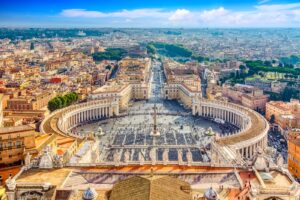“We will glorify war, the world’s only hygiene, patriotism . . . beautiful ideas worth dying for, and scorn for women,” declared the Futurist Manifesto (1909). We will build a “new structure of the future . . . which will one day rise toward heaven from the hands of a million workers like the crystal symbol of a new faith” wrote Walter Gropius in the Bauhaus Manifesto (1919). We artists must give “completely, without any reservations, our allegiance to the principle of historical materialism” demanded André Breton in the second Surrealist Manifesto (1929). “From mural painting will arise the ‘Fascist style,’” pronounced the Manifesto of Mural Painting (1933). “Everything one looks at is false,” retorted the Dadaist Manifesto (1938). All is nicely summarized by the Pandemonium Manifesto (1961), which concludes, “All writing is crap.” Indeed, a survey of the hotheaded artistic manifestos of the twentieth century induces a reflexive urge for some cynical postmodern relief.
A recent display at one of the most helpful monitors of the state of American art, the Whitney Biennial, makes the same point visually. Marianne Vitale’s video installation Patron, involves a room where the artist appears on a flatscreen television, announcing a new artistic movement entitled “Neutralism,” only to mock the exhibit’s viewers and scream out imperious commands such as “spit towards the ceiling.” The video, it is true, winsomely undermines the bombastic art manifestos of the century past. But Patron mocks the pretensions of the postmodern present as well. “Neutralism” is, after all, just another name for the widely held academic posture that claims to be beyond manifestos, but is in fact just another one in disguise. Which is to say, our post-postmodern moment has fully arrived, brought to you by the Whitney Museum of American Art. Manifestos continue to zoom by us—be they Classical Renewal or Avant-Pop surrender to the Digital Age—but it is tempting to give Marianne Vitale’s send-up of all manifestos, even postmodern ones, the last word.
And yet, there is one twentieth-century art manifesto that does endure, one that lacks either Utopian illusions or imperious claims to neutrality: Jacques Maritain’s Art and Scholasticism (1920). One reason for its endurance is the intensity with which the author suffered the meaninglessness that would later inform the Dada movement. As university students, Maritain and his future wife had made a suicide pact: if they did not find some degree of purpose in a year’s time, they would kill themselves. Meaning was summoned by the threat, appearing first in the philosophy of Henri Bergson, and later in the Catholic tradition to which Jacques and Raïssa (his wife) converted. Art and Scholasticism, therefore, was penned on the far side of despair, and was necessarily fortified with metaphysical grit.
In a previous essay at Public Discourse, I pointed to the series of recent publications that constitute a Maritainian revival of sorts, and I summarized the related ideas of one young scholar, James Matthew Wilson, including his refreshing attempt to connect this Maritainian resurgence to conservatism and his helpful recapitulation of Art and Scholasticism. But there are other New Maritainians to choose from, and I wish here to outline briefly the contributions of two more.
Start your day with Public Discourse
Sign up and get our daily essays sent straight to your inbox.Katie Kresser, a professor of art at Seattle Pacific University, received her Ph.D. in art history from Harvard, and her exploration of Maritainian aesthetics appeared in the quarterly arts journal Image, entitled “Night Vision: Jacques Maritain and the Meaning of Art.” Art historians today sink their theoretical fangs with relish into the soft flesh of neo-Kantian aesthetics or into the tender proposal that art serves as a proxy for American freedom. Kresser, therefore, begins by showing Maritain’s resistance to these critiques. She exploits Maritain’s focus on “pre-conceptual” knowledge (a concept that Maritain borrowed from Bergson). Kresser identifies this kind of poetic knowledge with “night,” thereby exploring an artistic darkness that borrows more from apophatic mysticism than from the negative infinity of the postmodern sublime. To quote one of her more successful formulations, the night is not emptiness, but “a black-bright flood that is Being itself . . .”
In Kresser’s words, the artists’ pre-conceptual intuition understands that a “permeable, spiritual structure inform[s] all matter, like a dazzling liquid skeleton, flowing and interlocking in glittering geometries.” Kresser is here articulating—alongside Stratford Caldecott—the wisdom of classical metaphysics in contemporary idiom. Matter, for Kresser, “is shot through with an order and a significance that makes the poet, the historian, and the mathematician alike cry ‘glory.’” The artist—ideally—should be at the forefront of this doxological parade, seeking transcendence not beyond, but in matter’s “crystalline filaments and swirling fractals of infinite, overlapping complexity.” Because her flights of rhetoric are sustained by a tested ontology, Kresser’s occasionally daring prose sound far more like genuine poetry than last year’s keynote address at Burning Man.
We might criticize Kresser’s quasi-Hegelian claim to identify what exactly the art of “our time” must be like, even if she does provide support for her theories from two contemporary artists (Jean Rustin and Josiah McElheny). But Kresser is especially convincing when she describes the contours of a Maritainian art education, which necessitates the mastery of a given material—discovering, over decades, what the material wants to say as well as what the artist hopes to say through it. “It is only by this means that students will be enabled, once mature, to build fluidly and organically in a manner proportionate to the breadth and complexity of their pre-conceptual lives.”
Another Neo-Maritainin is Gordon Fuglie, a contemporary curator who has left a trail of historically informed, aesthetically passionate prose. His Maritainian contribution appears in an intellectually serious and visually arresting publication entitled A Broken Beauty (Eerdman’s, 2005), edited by Theodore Prescott. Fuglie’s essay charts the loss of beauty as a concept in the art world, which he refers to dismissively (following the art critic Doug Harvey) with the acronym TAW. He also notes the recent resurgence of beauty as a concept, but warns that it too is in danger of becoming yet another passing manifesto. If it is to endure, beauty needs be anchored in deeper metaphysical waters, which leads Fuglie to Jacques Maritain.
Fuglie, however, takes an unexpected rhetorical approach by first linking Maritain to the twentieth-century Jewish art historian, Meyer Schapiro. Schapiro is a darling of contemporary art historians, some seeing in Schapiro—no doubt due to his Marxist commitments—the beginning of “real” art history in the United States. But, similar to James Matthew Wilson’s conservative appropriation of Theodor W. Adorno, Fuglie shows that Schapiro fits quite comfortably into the Maritainian world. Fuglie points to a major address given by Schapiro, “On Perfection, Coherence, and the Unity of Form and Content,” (1964), which is hardly an economically determinative reading of art. The downright Thomistic aesthetic qualities that Schapiro lists in the title of his address emerge not as neo-classical constrictions, but necessary ways of navigating beauty’s mysterious and disorienting terrain. Schapiro also calls also for “collective criticism” over time that tests a given work over generations, vindicating—or exposing—a given work’s aesthetic quality.
The further reflections of Fuglie and other scholars in this volume are well worth exploring, providing an extended diagnosis of TAW ailments, an elucidation of Maritain’s ideas, and an impressive string of contemporary artists who pursue not the visual sedation of prettiness but a beauty that can navigate suffering and loss. I have focused, however, on the Maritainian touchpoints that Fuglie establishes with Schapiro, because they remind us that Maritain’s philosophy of art “may be used profitably from within a secular viewpoint, since Maritain did not produce it solely from a religious perspective or to serve exclusively religious ends.”
In closing, I offer two small contributions to the Maritainian revival, in the form of criticisms. First, it is important to keep in mind the “friendly fire” that Maritain received from his Thomistic rival, Etienne Gilson. Their differences are nicely elucidated in Francesca Murphy’s essay “Gilson and Maritain: Battle Over the Beautiful” in A Thomistic Tapestry. Gilson effectively widens Maritain’s approach, appealing to different temperaments and sensibilities, thereby extending the potential guest list at the Neo-Thomistic aesthetic table.
Secondly, as Thomism has changed since the 1950s, so must our employment of Gilson and Maritain. Since the mid-century Thomistic ascendency, and somewhat in response to it, an entirely new—and yet, due to its Patristic inspiration, older—metaphysical project has arisen. Hans Urs von Balthasar’s project of frontloading metaphysics with aesthetic concerns has given us an embarrassment of conceptual riches from which to draw. Among the many who have taken his chiefly aesthetic project forward are Aidan Nichols (Redeeming Beauty), and David Bentley Hart (The Beauty of the Infinite). In the words of the latter:
So, now that Gilson and others who so enormously exaggerated Thomas’ originality no longer dominate Thomist scholarship, we may certainly, if we wish, retreat from Thomas’s exquisitely refined terminology to earlier moments in the continuous tradition of Christian ontology that he was interpreting—to the Cappadocians, or Augustine, or Maximus, above all to Dionysius the Areopagite.
All this is to say, while the New Maritainians are faced with certain cultural hostilities that Jacques Maritain did not encounter, they are equipped with fresh resources to which he did not have access as well.
Many consider serious thinking about art to be unnecessary. But to take that position—as too many conservatives have—is to yield the aesthetic domain to those who are willing to think seriously about art. For the last several decades, such thinkers have been inspired chiefly by twentieth-century French thought, which according to Martin Jay’s magisterial study Downcast Eyes, has uniformly denigrated vision, bequeathing “a palpable loss of confidence in the hitherto ‘noblest of the senses.’” The general public’s alienation from TAW is a direct result of the triumph of this “Neutralist” perspective. The New Maritainians, however, provide an equally serious alternative, one that can be additionally fortified with the aforementioned supplements. Beauty—any visitor to Manhattan’s Chelsea gallery district will find themselves concluding—is steadily mounting a clandestine return. It is no wonder, therefore, that Jacques Maritain, one of its most able elucidators, has as well.












